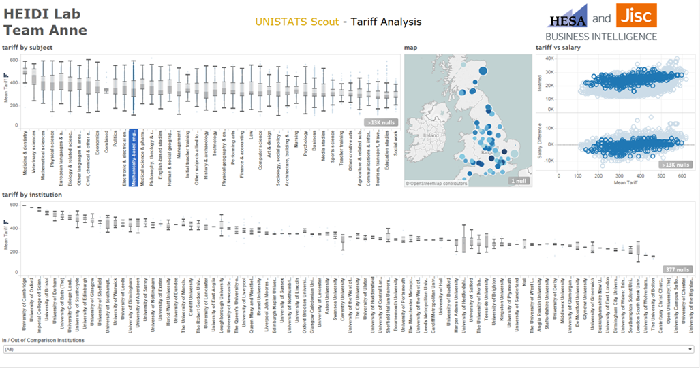The Jisc-HESA Heidi lab project has brought professionals from a range of universities together to create dashboards for the sector’s new Heidi Plus business intelligence (BI) service. Anne Buckle, who took a leading role in one project team, highlights some of the benefits of this model of collaboration.
We all know how important efficiency is to higher education, particularly in the current climate. But what happens when you reach the limits of reasonable efficiencies within your own institution?
Collaborative models of working across the sector are a great way to gain efficiencies through shared resources and expertise. They can present opportunities for real step changes in effectiveness and value for money.
Jisc’s Heidi Lab, part of a joint Jisc-HESA BI project, is a perfect example of how to develop cross-sector collaborative working to address specific issues but also add value to institutions and generate sector-wide efficiencies.
About Heidi Lab
The project brings together staff from different institutions to work in teams on developing sector-wide solutions. Using the ‘agile’ development methodology, each team develops prototypes in a short timespan – one day per week over 3 months – which, if successful, will be taken on for further development and rollout by HESA, Jisc or others.
The project began in Autumn 2015, and prototype solutions have already been produced through two development cycles that will save each UK higher education institution staff time several magnitudes greater than that being committed to the project. And on a recurrent basis to boot!
As ‘product owner’ for a second cycle team, I was at a showcase event in London to see the solutions developed by cycle 1 teams. The range of problems being tackled was extensive and the proof-of-concept solutions being presented were impressive, to say the least.
I was personally able to identify potential savings of a couple of hundred staff hours at my own institution alone, and a huge saving in opportunity cost as a result. Multiply that across the sector and you start to see the scale of the potential on offer!
Experiences of cycle two
My own team, comprising staff from Aberdeen, Birmingham City, Greenwich, Northumbria, Southampton Solent and Sunderland universities, along with Jisc colleagues, began working together in February and presented our prototypes at a second showcase in June.
We focused on building an evidence base to support strategic decision making and curriculum design, and offering intelligence insights and tools for analysis of factors impacting on student retention, progression and achievement.

By June, we had a set of fully functional BI dashboards which, if rolled out via HESA, will help institutions compare their provision to that of competitors, and to examine correlations between aspects of curriculum design and student success factors. The level of detail available via these dashboards is something not readily accessible to individual institutions, and by combining often difficult to access data sources, we are able to offer powerful and meaningful insights which will add value and agility across the sector.
Benefits of involvement
At the most pragmatic level, all of the team now have experience of working with agile, something which I’m sure we’ll use in future. For the development members of the team, they also had chance to gain or improve skills in the technologies and software being used.
On a more cerebral level, the opportunity to work on developments which have potential sector-wide impact has been hugely rewarding for all of us. And even if our dashboards aren’t rolled out, those involved in the project now have the ability, confidence and acumen to develop similar solutions for their own institutions.
What next?
Consideration is now being given to taking the project forward longer-term, but support from the sector could make a huge difference to our ability to capitalise on these early successes.
It is already apparent from my experience of Heidi Lab that the longer this model of collaboration continues and the degree of expertise increases, the greater the benefits we all reap. Within my own team, I could feel the pace of innovation and development speed up exponentially over the three months we worked together and it’s clear to me that longer-term collaboration, if structured correctly, has the potential to increase return on investment significantly.
In order for the impact to be as wide-reaching and lasting as possible, it requires the sector to embrace this way of working and to commit to continued time and investment. Institutions need to be willing to routinely look outside their own walls (and allow staff to do the same) in a more collaborative and creative way: if such a commitment is made, the potential for improving efficiency and real business intelligence across the whole sector is inestimable.








